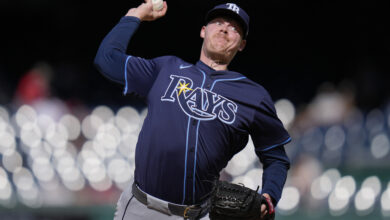
Cubs’ Offensive Inconsistency Fueled by Poor Batted-Ball Numbers
Remember how fun the Cubs’ offense was earlier this year?
In the midst of the team’s best stretch of the season from about mid-April to mid-May, everything appeared to be “fixed.” The Cubs were near the top of the league in runs scored and nearly every single player seemed on pace to obliterate their home run totals from the year before. There was no shortage of Chili Davis jokes the launch-angle fad came back into vogue.
It was fun!
While many Cubs are still are on pace to comfortable surpass their previous home run tallies, the offense has not otherwise demonstrated much consistency. Their drop from first to fifth in runs scored among National League teams since May 1 speaks to that frustrating performance.
Some of the factors contributing to that drop-off have gotten significant attention, from poor production with runners in scoring position to a maddening lack of production from the bottom third of the lineup. You don’t need to be a dermatologist to discern those warts because they’ve become all too obvious to even casual observers.
Digging a little helps illuminate why the Cubs haven’t quite been what they’re capable of. Their batted-ball statistics are a particularly ugly indicator of their offensive struggles, with a number of pretty alarming metrics listed below. Last year’s are included for reference and all rankings are based on the desirability of the metric (so being further away from first is always bad).
| 2018 | 2019 | |
| Line drive percentage | 21.4% (17th) | 19.2% (30th) |
| Ground ball percentage | 46.0% (28th) | 46.9% (29th) |
| Soft contact percentage | 19.6% (28th) | 17.4% (20th) |
| Hard contact percentage | 31.7% (19th) | 35.8% (23rd) |
Yikes. Statcast presents a slightly rosier view by showing the Cubs to have an above-average barrel rate of 8.3%, but that doesn’t erase the troublesome indicators above. Hitting the ball on the ground even more than last year and failing to produce high quality of contact just isn’t going to get it done.
This isn’t really an indictment of the Cubs’ stars, as the batters in through the top half of the lineup are still generating the numbers you’d expect given their level of production.
That aforementioned bottom third of the lineup is more responsible for the Cubs’ struggles. Albert Almora Jr., Jason Heyward, Carlos González and Daniel Descalso all find themselves in the bottom third of the league in hard-contact percentage. Descalso and Almora actually fall in the bottom 15%, and one or the other of those two is in the lineup most nights.
We know the Cubs offense is capable of more than what we’ve seen here in June, but it’s hard to be consistently excellent when the quality of contact from a third of the lineup on any given night is so poor. Jed Hoyer admitted that the team may “look outside” for answers on offense and the apparent end of the CarGo era is another signal that the front office is well aware that the team as it stands is not a finished product.
If the Cubs can’t improve those numbers from within and are truly committed to their mantra of “production over talent,” you’d have to think that search for outside help has already begun.

